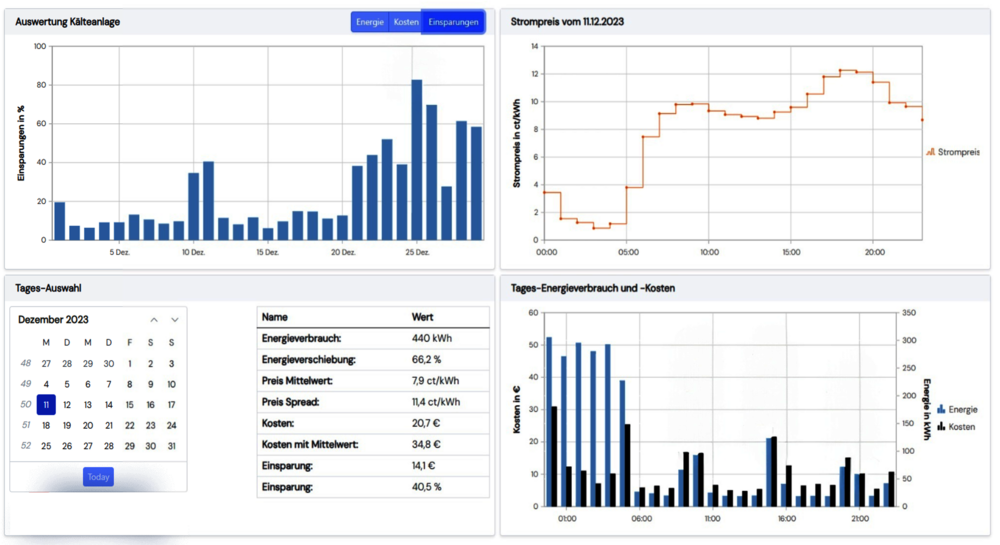Cold storage facilities need a lot of energy, especially in the form of electricity. This makes them a perfect source of flexibility. Start-up company Flexality has developed an AI-based software that turns industrial facilities such as freezer warehouses into flexible electricity consumers. This eases the strain on the grid and helps companies reduce their carbon emissions, cutting their energy costs by an average of 20 percent.
Flexality, a start-up company based in Bremen, Germany, has developed a self-learning software for smart energy management in the industrial sector. This software helps reduce the energy costs and carbon emissions of cold storage and other types of facilities. As it turns out, these frosty warehouses make great energy buffers when power generation from the sun and wind exceeds demand.
It is estimated that there are 750 large-scale cold storage facilities in Germany alone – potential that is vital to advance the energy transition. For this reason, the German Federal Environmental Foundation (DBU) is investing 125,000 euros in the development of Flexality’s software. Several corporate customers are already using it.
The start-up was founded in 2022 by three university friends and a fourth person. One of the founders and managing directors is Dyke Wilke, who met one of his co-founders at university during a beer-brewing course. “Guided by our lecturer and following a recipe, we brewed 500 liters of beer per month. Without a doubt, it is one of the greatest types of process engineering,” Wilke reminisces.
Flexality’s service is targeted at anyone who operates, plans or builds a thermal installation and wants to use a superordinate energy management software to optimize their consumption according to electricity and carbon prices. “As process engineers, we can address each customer’s individual challenges and tailor the software to their needs,” describes Wilke. To this end, the start-up sets up a local gateway at the customer’s site that gathers all the data required for flexibilization, and retrieves cost-optimized roadmaps from the cloud. This combination of data collection and controlling is a first in the market. Some large companies optimize and control these processes themselves, but not every medium-sized enterprise can afford to do that. “We make sure to keep the customer’s involvement to a minimum so they can continue to focus on their core business,” founder Wilke explains.
Flexality’s software, fEnOMS, uses artificial intelligence and is self-learning. Depending on the customer, the aspects that are relevant for optimization may differ. For some, it may be more effective to reduce energy costs by purchasing electricity, while for others it may be better to reduce grid charges. The savings potential is huge: “On average, our customers save 20 percent on electricity costs,” says Wilke.
In addition to optimization according to commodity price, it is also possible to optimize savings through grid charges. “What’s more, we are now starting to market flexibility on other electricity markets, such as the intraday market,” he explains. In principle, the balancing power market could serve as an additional source of revenue. The energy flexibility largely depends on the size of the facility and the number of pallet spaces. “Typically, several hundred kilowatts per cooling system can be shifted by up to five hours,” Wilke reports.

Energy management not only optimizes companies’ costs and emissions, it also supports the energy system by providing more flexibility. This reduces the load on power grids and the need for electricity highways. “When the price of electricity at the power exchange drops due to peak generation from renewable energy sources, the temperature in the cold stores is simply lowered below the usual level,” Wilke explains. When there is less renewable energy available, the temperature is simply reset to the normal level. This way, cold storage facilities consume less energy when grid prices are high, and increase power consumption when spot electricity prices decrease.
For the FlexKaelte project, the Fraunhofer Institute for Environment, Safety, and Energy Technology (UMSICHT) determined the total energy demand of Germany’s cold storage sector. It is currently at 92.7 terawatt-hours – 85 percent of which is electric and 15 percent thermal energy, Christoph Goetschkes, researcher at UMSICHT sums up. Research showed that cold storage applications tend to be highly heterogeneous. According to a meta study, in order to flexibilize the cold supply systems, every site needs customized recommendations on how to design and operate the system.
The start-up Flexality is also planning to expand its optimized energy use to other industries. The Flexality energy management is not only useful for cold temperatures, it can also be used in heating applications for steam-driven operations. This works best for processes requiring more flexibility. “Things get particularly interesting in hybrid systems that use gas and electricity,” says Wilke. This level of complexity is not a problem for the software. “It runs in the background, taking care of everything automatically without requiring the customer’s attention.”
The demand for solutions that cut carbon emissions is set to rise across industries. At present, companies reducing their carbon emissions are only doing it to earn brownie points. However, the EU’s requirements will soon be in force and all of Germany’s industry will be obligated to meet them. Investors certainly know to appreciate Flexality’s software. At the start of this year, the start-up company received one million euros in fresh capital, with the majority of the investment coming from Buhlmann, a Bremen-based steel trading company. Wilke is now looking to hire new staff to help with all the work ahead. “We have big plans and we are excited about all the projects in our pipeline,” Wilke cheerfully reports.